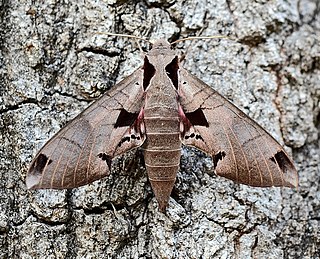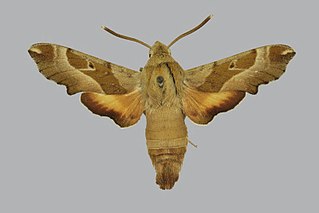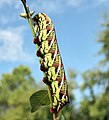
Ceratomia catalpae, the catalpa sphinx, is a hawk moth of the family Sphingidae. The species was first described by Jean Baptiste Boisduval in 1875. Other common names are the Catawba worm, or Catalpa sphinx.

Laothoe populi, the poplar hawk-moth, is a moth of the family Sphingidae. The species was first described by Carl Linnaeus in his 1758 10th edition of Systema Naturae. It is found throughout the Palearctic region and the Near East and is one of the most common members of the family in the region. It is distinctive due to its habit of resting with its hindwings held further forward than the forewings.

Manduca rustica, the rustic sphinx, is a moth of the family Sphingidae. The species was first described by Johan Christian Fabricius in 1775.

Eumorpha pandorus, the Pandora sphinx moth or Pandorus sphinx moth, is a North American moth in the family Sphingidae. The species was first described by Jacob Hübner in 1821.

Ceratomia amyntor, the elm sphinx or four-horned sphinx, is a North American moth in the family Sphingidae. The species was first described by Carl Geyer in 1835. It has a wingspan of 3+1⁄4-4+1⁄2 inches. As the name suggests, the larvae (caterpillars) feed on elm trees (Ulmus), but they can also be found feeding on birch (Betula), basswood (Tilia), and cherry (Prunus). When the caterpillars are ready, they crawl to the bottom of the host tree, where they crawl underneath the soil and pupate and may overwinter underground if late enough into the year. Vegetable growers should be aware of this larvae due to its insatiable appetite. One of these larvae are capable in devouring huge amounts of plant's foliage and even succulent stems.

Sphinx chersis, the great ash sphinx or northern ash sphinx, is a moth that belongs to the family Sphingidae.

Eumorpha labruscae, the gaudy sphinx, is a moth in the family Sphingidae.

Eumorpha is a genus of moths in the family Sphingidae. The genus is mostly found in North and South America.

Sphinx franckii, or Franck's sphinx moth is a moth in the family Sphingidae. The species was first described by Berthold Neumoegen in 1893. It is known from lowland deciduous woodland in the eastern United States but also suburban areas where lilacs are planted, ranging from New York to northern Florida east to Missouri and Louisiana.

Pachysphinx modesta, the modest sphinx or poplar sphinx, is a moth of the family Sphingidae. The species was first described by Thaddeus William Harris in 1839.

Pachysphinx occidentalis, the big poplar sphinx, is a moth of the family Sphingidae. The species was first described by Henry Edwards in 1875. It lives throughout Canada and the United States. The habitat consists of riparian areas and suburbs.

Eumorpha achemon, the Achemon sphinx, is a moth of the family Sphingidae. The species was first described by Dru Drury in 1773.

Eumorpha anchemolus, the anchemola sphinx moth, is a moth of the family Sphingidae. The species was first described by Pieter Cramer in 1780.

Eumorpha intermedia, the intermediate sphinx, is a moth of the family Sphingidae. The species was first described by Benjamin Preston Clark in 1917. It lives in the US states of North Carolina, Florida, Mississippi, Louisiana, and southern Texas.

Eumorpha satellitia, the satellite sphinx, is a moth of the family Sphingidae. The family was first described by Carl Linnaeus in 1771. It lives from Brazil and northern Argentina north through Central America, Mexico, and the West Indies to south Texas and southern Arizona.

Eumorpha typhon, the Typhon sphinx, is a moth of the family Sphingidae. The species was first described by Johann Christoph Friedrich Klug in 1836.

Eumorpha vitis, known as the vine sphinx, is a moth of the family Sphingidae.

Hyles lineata, also known as the white-lined sphinx, is a moth of the family Sphingidae. They are sometimes known as a "hummingbird moth" because of their bird-like size and flight patterns.

Sphinx kalmiae, the laurel sphinx, is a moth of the family Sphingidae.

Proserpinus gaurae, the proud sphinx moth, is a moth of the family Sphingidae. The species was first described by James Edward Smith in 1797. It is found from Texas and Louisiana east to northern Florida, north to Alabama, Missouri, northern Georgia and South Carolina. It may range as far south as northern Mexico.



































